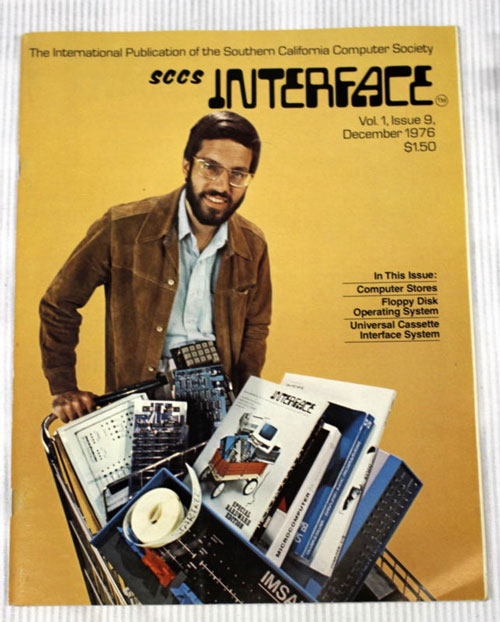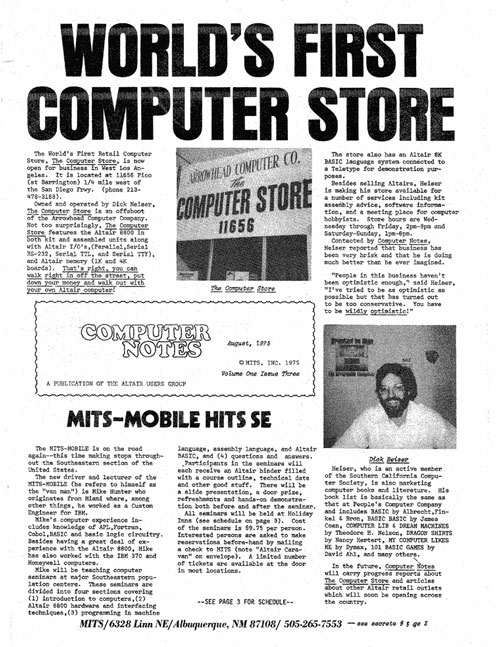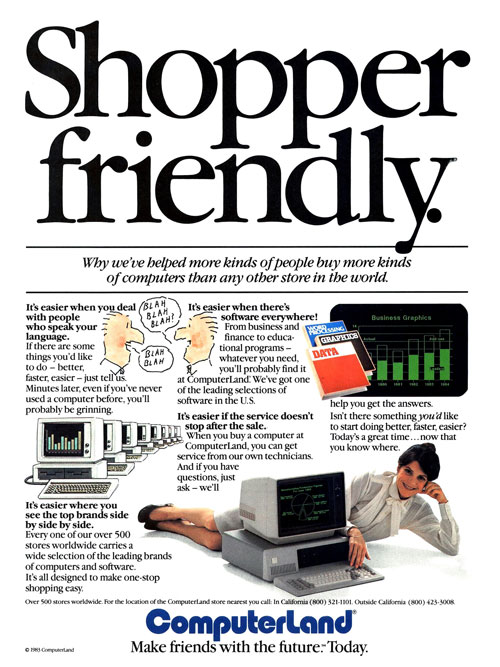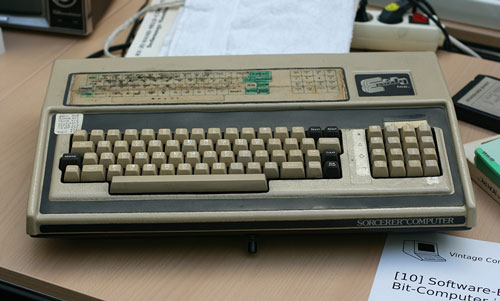Booting Up The Cash Register
Computers didn’t immediately lend themselves to retail, but ambitious early computer retailers sold ‘em anyway. Eventually, they got trampled.
Sponsored By … You?
If you find weird or unusual topics like this super-fascinating, the best way to tell us is to give us a nod on Ko-Fi. It helps ensure that we can keep this machine moving, support outside writers, and bring on the tools to support our writing. (Also it’s heartening when someone chips in.)
We accept advertising, too! Check out this page to learn more.
$600
The starting price for the TRS-80, which Radio Shack put on sale for the first time on August 3, 1977. It wasn’t the first personal computer, but it was perhaps the first to be sold by a major retailer. The device came a mere two years after the first independent computer retailer opened its doors.

Early computer store owner Dick Heiser, shown on the cover of Interface, the magazine of the Southern California Computer Society. (via eBay)
The early risk-takers who proved that retail actually made sense for computers
Starting a computer store in the mid-1970s was not exactly a low-risk endeavor, to put it lightly.
In mid-1975, computer hobbyists were starting to crop up, with clubs of enthusiasts helping to build energy around a potentially budding movement. But this was a time when computers—specifically, the Altair 8800, only released in January via a Popular Mechanics cover—were only starting to show up in magazines, for sale in kit form. Mail-order, then and now, is the natural element for selling computers.
But this was a completely speculative market at the time. Byte magazine, perhaps the first mainstream computer magazine, was still a few months away from launch, inspired by the success of computer-related articles in the ham radio magazine 73.
Things were clearly starting to head in a certain direction, but the industry’s full potential? Still quite a ways off. It was a risky environment to start a computer store in, but a Santa Monica guy named Dick Heiser was ready to take the first arrow. He clearly realized it, because his company’s name referenced this fact.
On June 15, 1975—Father’s Day, by the way—Heiser, the owner of the Arrowhead Computer Company, took part in a Southern California Computer Society event, and found that there was an overwhelming excitement for the Altair 8800 in particular. And that led him to open up a store in Los Angeles—which he literally called The Computer Store—exactly a month later.
The Altair ultimately proved the main reason for the store’s early existence.
“I had been thinking about putting in video games, workbenches, timesharing terminals, but because the Altair was so hot at the time, I decided to start the store to sell Altairs and help people get the kits together,” he recalled in a 1981 Infoworld article.

Excellent design sensibility. (via Medium)
With just a $10,000 investment, he was off to the races. The August 1975 issue of Computer Notes, produced by the Altair maker MITS, played up the novelty of the event. In massive bold type often reserved for Moon landings or presidential inaugurations, the magazine proclaimed WORLD’S FIRST COMPUTER STORE in its headline, and featured this line in the story: “That’s right, you can walk right in off the street, put down your money and walk out with your own Altair computer!”
Soon, Heiser wasn’t alone. In late 1975, a guy named Paul Terrell opened up a computer store in Mountain View, California called The Byte Shop, more explicitly modeling his concept on Radio Shack. Within a couple of years, he had dozens of stores, and a place in computer history thanks to a couple of guys who knew how to take advantage of a competitor’s arrogance.
See, MITS loved the idea of stores selling its computers—it was selling 10,000 units a year by the end of 1976—but it was dead set against those stores selling its competitors.
Dick Heiser, who had initially gotten into the industry thanks to the Altair, ran into this problem head-on himself. In the book Digital Deli, Heiser noted that MITS put the business in a difficult financial position by requiring pre-payment for any computer sold.
“I thought that was a strange way to do business,” he noted, “but there didn’t seem to be any other way. At one point MITS had all our money and some of our customers’ money and we didn’t have any inventory in the store.”
Eventually, the company’s desire to control the store’s inventory pushed Heiser away.
“At the end of 1977 we were finally forced to sever our relationship with MITS because they would not allow us to carry competitive products,” he told InfoWorld.
But ultimately, he found that it was the best move: “We thought that customer loyalty was to the product, so we were reluctant to change brands. However, we found that we didn’t lose any customers. They wanted to deal with us.”
And a few hundred miles north, that was a lesson that worked particularly well for Paul Terrell. Suddenly in the need of a new product line, he listened to a couple of bearded hippie types who had started their own computer company—you know where this is going—and soon enough, the Byte Shop was selling the Apple I. Shortly thereafter, thanks in part to a merger with a larger company, MITS became a footnote in computer history.
Even with the right partners, the retailers found themselves having to sell a complicated product to people who were completely unfamiliar with concepts we now take for granted, and whose opinions on the devices had been unfairly colored by the media.
“Computers are becoming personal,” Terrell told the Associated Press in 1977. “We want to make them friendly, because people think of them as the archenemy of the credit card company. One of the biggest takes we have to perform is educating the public on what these machines can do and how they might be useful to them.”
Eventually, the computer retail industry figured this all out. The problem was, they weren’t powerful enough to keep up with a group of fast-growing tech giants.
$400M
The estimated amount Computerland reported it would make in sales in 1982. The firm, which launched as Computer Shack in 1976 before a certain electronics chain took umbrage with its name, was associated with IMSAI, a computer maker that had come out with a clone of the Altair. The retailer sold other computers, and those competitors ultimately proved more popular than IMSAI products. Within a few years, ComputerLand had become the nation’s largest computer retailer, and IMSAI had faded away.

This ComputerLand ad uses a larger headline typeface than the “World’s First Computer Store” story does. Just wanted to point that out. (Tom Simpson/Flickr)
How the computer giants burned the little guys and ensured we’d be buying upgrades from superstores
The thing that’s really bizarre about the early days of Byte Shop and The Computer Store, among other chains, is that it basically sounds nothing like our modern day retail experience. The modern-day equivalent of Steve Jobs and Steve Wozniak would never walk into a computer store and score a deal with a retailer directly.
And a big part of that comes down to a single problem: Simply, the computer companies got more powerful than the retailers, and they consolidated their power. The retailers, for the most part, didn’t—and that ultimately limited their influence.
Perhaps the most notable hints of this came in the early 1980s. IBM, rather than working with the array of small retailers that had cropped up around the Altair and the Apple II, relied on Sears and ComputerLand as its primary retail channels—a decision which probably played a role in the growth of the clone market.
Meanwhile, Apple terminated a deal with ComputerLand to automatically offer the company’s computers to the retailer, because the retailer, which was explicitly designed to go national, was growing faster than the computer giant was comfortable with.
In comments to The New York Times, Apple spokesman Fred Hoar put the problem in this context: “What if you have five stores on the same corner? We simply don’t feel that the uncontrolled addition of outlets is something we can continue to live with.”
A 1990 report from BusinessWeek noted that computer-makers had taken steps to diversify their market foothold, in part because traditional computer retailers were struggling. When IBM chose to sell its computers at Sears, that was a transaction that a traditional computer retailer had no chance of getting.
The market had expanded well beyond the area of the hobbyist quite quickly, and manufacturers were more prepared for the shift than the retailers were. In fact, the manufacturers made things pretty tough on the retailers.
“Ironically, computer makers helped bring on the chains’ current woes. In the mid-1980s, PC makers insisted that dealers operate from costly store-front locations to attract walk-in business,” author Lois Therrien wrote. “But a market slump and a resulting price war forced scores of independent stores out of business. Dozens of others were merged into the big, national chains.”
Part of the issue may have been a lack of organization on the part of retailers. Ray Borrill, who was a local legend in Bloomington, Indiana for launching one of the first computer stores in the Midwest, noted in a 1982 InfoWorld article that the independent retailers had failed to organize themselves under the guise of a professional association.
“Retailers still are amateurish enough to consider themselves competitors,” he noted. “They are just too immature to realize that they’re complementary, not competitive.”
Even ComputerLand, a franchise-driven chain supposedly associated with one corporate structure, had this problem. By the latter half of 1985, the chain’s owners were fending off a takeover attempt in court, the company’s franchisees were closing up shop left and right, and some of the chain’s most popular stores were threatening to go independent over high franchise fees. (The founder, William Millard, stepped down as CEO in the midst of all this.)
And this problem ultimately put independent retailers at a loss. Soon, we were buying our computers at Circuit City and CompUSA, from manufacturers like Packard Bell, which were basically built less for quality and more for selling to first-time buyers.

An Exidy Sorcerer, masterminded with the help of Paul Terrell. (Wolfgang Stief/Flickr)
Strangely enough, the earliest players in the industry were the ones who jumped out the quickest and received the fewest scars. Paul Terrell sold off his Byte Shop chain in 1977, then launched his own computer, the Exidy Sorcerer, the next year. (He later re-entered retail, but with a completely different concept—he started renting computers and software.)
And by 1982, Dick Heiser had sold off The Computer Store, which had become a profitable business but had shifted due to all the changes in the computer industry, in favor of writing books and teaching.
It didn’t last. But for a couple of years, computer retail was a happening place—as it should have been.
The one guy who had perhaps the most success in the early years of computer retail might be the one with perhaps the most bizarre second act.
William Millard, who built the country’s largest chain of computer stores with ComputerLand, had failed so hard that his failure had become a cautionary tale in Inc. Magazine.
And even though he still had his wealth, he also had something else: A gigantic unpaid tax bill. For two decades, as his former company had faltered, he traveled the world, amassing a massive tax bill in the process—particularly in Saipan, a country he moved to, ironically, because of a tax incentive.
Around 1990, he disappeared from view. But by 2011, when private investigators hired by the U.S. commonwealth helped Saipan actually find him—in, of all places, the Cayman Islands—the bill, with additional fees, had tipped up to more than $100 million.
Millard argued that he was the victim of political corruption—something supported by the fact he was a witness in a political corruption case on the island more than three decades ago—but his two-decade disappearance, let’s just say, didn’t look good.
Now, Millard eventually settled for a much smaller amount, but the saga is perhaps the thing he’s most known for these days.
Well, that, and helping to kickstart the computer revolution.
--
Find this one an interesting read? Share it with a pal!
:format(jpeg)/2017/08/tedium080317.gif)
/2017/08/tedium080317.gif)


/uploads/ernie_crop.jpg)